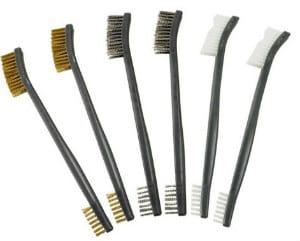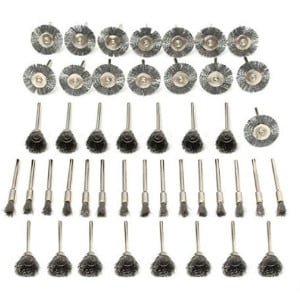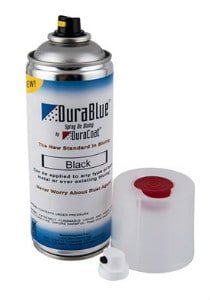An ounce of prevention truly is worth a pound of cure. The best way to get rust off of your guns is to not let it get there in the first place! In the real world, however, mistakes happen. I would be a liar if I didn’t admit that I found myself cleaning a few rust spots off of my most prized possessions every now and then. A more likely scenario is that you simply acquired a gun that was already covered in rust. I have purchased numerous rust buckets in my day, and you can usually get a pretty hefty discount on a firearm that is coated with the ugly brown junk. There is no need to worry though, removing rust from a gun is actually a relatively easy process and can be accomplished in many different ways. If you want to get that old rifle shined up and looking like new, then keep reading!
Related Articles:
- Learn Here: Gun Lubrication 101 [Know Your Stuff]
- Easy! How to Store Guns to Prevent Rust [Eliminate Moisture]
- Safety First! How to Use a Gun Cleaning Kit [Instructions]
- Don’t Overdo It! Can Guns be Over Cleaned? [Right Tools]
- Question: How Often Should You Clean Your Guns? [Like New]

Related Buyers Guides:
A Word Of Warning
Before we start, we need to address the fact that there are about a hundred different ways to clean rust off of any surface. Most of these can be used on firearms, but there are a few methods that will actually cause more harm than good if you try them. This is due primarily to a very popular finish used on older firearms: bluing. Bluing a firearm is a very extensive process that I won’t cover in depth here, but basically, it lightly oxidizes (or rusts) the surface of your firearm. If you are careful and follow the process correctly, it gives you a very durable, corrosion resistant finish. Since it is technically rust, many of the methods you will find for removing rust on a gun will also remove your bluing. This means that you will either need to be very careful in your rust removal and go back over the exposed metal with some cold blue. I like to use the liquid cold blue from (Birchwood Casey). It’s not perfect, but it will protect your metal and prevent you from having unfinished splotches.
Oil And Elbow Grease
 If you have a firearm that is blued, this is probably the best method for removing rust. A bonus to this method is that you probably already have everything you need for your gun cleaning kit! This method is pretty hard on your brushes though, and will more than likely tear them up pretty good. I would suggest purchasing a spare set so that you won’t ruin your good gun cleaning brushes. This 6 pack of No products found. Tools includes 2 brass, 2 steel, and 2 nylon brushes. This method is really pretty self-explanatory. Slather on a good coat of oil, and go to town on the rust spots with your brushes. I would try to avoid using the steel brush, as it will be much easier to ruin the remainder of your finish. The brass brush will take quite a bit more work but will give you a much better-finished product.
If you have a firearm that is blued, this is probably the best method for removing rust. A bonus to this method is that you probably already have everything you need for your gun cleaning kit! This method is pretty hard on your brushes though, and will more than likely tear them up pretty good. I would suggest purchasing a spare set so that you won’t ruin your good gun cleaning brushes. This 6 pack of No products found. Tools includes 2 brass, 2 steel, and 2 nylon brushes. This method is really pretty self-explanatory. Slather on a good coat of oil, and go to town on the rust spots with your brushes. I would try to avoid using the steel brush, as it will be much easier to ruin the remainder of your finish. The brass brush will take quite a bit more work but will give you a much better-finished product.
Once you’ve gotten as much of the rust removed as you can with the brass brush, it’s a good idea to finish it off with a light rubbing of steel wool. At this point, you will notice that you will have a few areas of your firearm where the bluing or other finish is gone due to the rust. If you simply leave this metal unprotected, it will begin to rust again in a matter of minutes and all of your hard work will be undone. Depending on the extent of the rust, protecting your newly cleaned metal will probably not be too hard. If it was a few light splotches, a little dash of cold blue will more than suffice. If it was a larger area though, you may be better off completely refinishing your entire firearm.
Dissolve The Rust With Acid
Another popular method for removing rust is dissolving it with acid. Most strong acids are good for dissolving iron oxide (rust) and in fact, most chemical rust removers are simply strong acids. You can use a powerful commercial product, such as the rust remover from Goo Gone or you can simply use vinegar. This is a very easy and simple method, as the powerful acids do most of the work for you. Simply soak your rusty parts in the solution (or in the case of the Goo Gone, spray it on the rust) and wait for a while. Depending on how rusty and large your parts are, this can range from a few hours, to overnight. After you’ve let the Acid do its work, simply wipe the rusty goo off the surface, and you’re good to go.
While this is a great method for removing rust in general, it does have a few downsides. For starters, the acid is probably not going to get all the rust. You are still going to have to do a bit of scrubbing with your brass brush. You can also probably bet on the acid destroying what is left of your finish. This can prove to be an effective method for a gun that is entirely covered in rust, but you can pretty much guarantee you will be refinishing a large portion of your firearm afterward. This is going to be a job that is much too large for your bottle of cold blue, so you will want to either have it re-blued by a gunsmith or look into an alternative finish such as Duracoat or Cerakote.
More Related Articles:
More Related Buyers Guides:
Power Tools
 If you’ve got a real problem child on your hands, it might be time to get a little rough with it. If you’ve acquired a firearm that has been sitting in a barn for years or otherwise badly neglected, it’s likely to be covered in rust and pitting. A job like this is probably going to require the use of some power tools. An angle grinder with a wire wheel is very effective at removing rust quickly and will give you a bit of a polish as well. If you’re not quite to that point yet, a small wire wheel set for your rotary tool will give you a lot of cleaning power that is also precise.
If you’ve got a real problem child on your hands, it might be time to get a little rough with it. If you’ve acquired a firearm that has been sitting in a barn for years or otherwise badly neglected, it’s likely to be covered in rust and pitting. A job like this is probably going to require the use of some power tools. An angle grinder with a wire wheel is very effective at removing rust quickly and will give you a bit of a polish as well. If you’re not quite to that point yet, a small wire wheel set for your rotary tool will give you a lot of cleaning power that is also precise.
Surely this goes without saying, but if you use this method, you will probably need to refinish the entire firearm when you are done. Another quick word of note here, if your firearm is to the point where you need an angle grinder to get all rust off, it might no longer be safe to shoot. Deep pitting and extensive rust can severely weaken your metal. At this point, your best bet will be to take it to a gunsmith. Any good gunsmith should be able to inspect the firearm and give you a good, honest opinion as to the safety of that firearm. The last thing you want is grandpa’s old deer rifle blowing up in your face after you worked so hard to make it look good again!
Electrolysis
Electrolysis is a fairly new method of rust removal that not too many people know about. This method certainly isn’t fast, but it is very easy once you get your tank setup. You will want to start with a 5-gallon bucket filled with an electrolyte solution. This is typically water with washing soda (sodium carbonate) mixed in. you will also need a sacrificial anode, which can be any ferrous object (I usually use rebar) and a DC power source. Most people use a battery charger for the power source, but you will need to be sure that you don’t use one of the newer “smart chargers.” These need to detect the presence of a battery before they supply voltage, and are no good for electrolysis rust removal.
Once you’ve got all of your supplies gathered, the rest is really easy. Connect the NEGATIVE LEAD (this is important) to the part of your gun that needs to be cleaned. Likewise, you will connect the positive end to your sacrificial anode. After placing both of these items in your plastic container, turn on your power source. As electricity flows from your rusty gun parts to your anode, you will notice bubbles start to form and the rust will very slowly start to flake off. If you come back several hours later, you should notice a satisfying film of gunk and rust on top of the electrolyte solution. This is a good thing, as it means that it’s taking it all off of your firearm.
Once you think it’s been in the cleaning solution long enough (overnight is usually more than adequate) you can take your firearm out, clean off any rust that is still stuck on, and make sure that the entire part is clean and dry. If not, it won’t be long before rust starts to form again. Overall, this is one of the best ways to remove heavy rust from your guns. This is the method that I usually elect to use anytime I purchase a batch of “gunsmith special” surplus rifles from an importer.
The Rust Is Gone, Now What?
 One thing that every rust removal method has in common is that it will always require some finish work. If rust is on your firearm, odds are it has probably already destroyed the protective finish and will return quickly if you don’t do something to prevent it. As I have mentioned above, cold blue is great for small parts, but bigger jobs require something totally different. If you have to refinish your entire firearm, you could go with a tradition hot salt blue or even parkerizing. Unless you have skills beyond your basic home gun cleaning, these are both going to be very challenging to undertake. Thankfully, there is a very easy way to get a durable, protective finish that is both affordable and easy to apply.
One thing that every rust removal method has in common is that it will always require some finish work. If rust is on your firearm, odds are it has probably already destroyed the protective finish and will return quickly if you don’t do something to prevent it. As I have mentioned above, cold blue is great for small parts, but bigger jobs require something totally different. If you have to refinish your entire firearm, you could go with a tradition hot salt blue or even parkerizing. Unless you have skills beyond your basic home gun cleaning, these are both going to be very challenging to undertake. Thankfully, there is a very easy way to get a durable, protective finish that is both affordable and easy to apply.
Duracoat finishes, while far from the best on the market, are incredibly easy to apply, and require absolutely no special tooling. For those who are only looking to do small jobs, Duracoat provides a “can within a can” aerosol technology. Applying this coating really is just as easy as applying spray paint. It is a bit more expensive than just purchasing the liquid but saves you the startup costs of purchasing all the tooling. It also does take up to a month to fully cure, but this avoids having to use an oven like you would with Cerakote. Overall, this is a great finish that looks excellent on almost any firearm.
Rust Removal Final Thoughts
It seems like almost everybody has their own foolproof, tried and true method for removing rust. In my opinion, these are 4 of the best ways to clean rust off of your guns, and I’m sure that at least one of them will work for you. The exact method that I use varies widely, and depends on the firearm, the finish, and how much rust I’m trying to get off. I have done everything from removing a few spots to a complete restoration using any of the 4 methods above, and all have worked out great for me. I hope you enjoyed reading this article and gained a few ideas on how to tackle your own project. If you’re looking for more than what you see here, please review our Best Reloading Kit Buyers Guide and our Best Gun Safe Buyers Guide.
Footnotes:
Even More Related Buyers Guides:
- The Family Handyman: How To Remove Rust from Metal

Dan is an avid outdoorsman and shooter who developed a passion for firearms at an early age. When you can’t find him in the field chasing birds or big game, you can find him at the range shooting various competitions such as 3-gun, IPSC, and IDPA. He also enjoys manufacturing his own ammunition, as well as both working on, and building his own firearms. Dan has many years of firearms experience, and enjoys helping people find the right gear and sharing his extensive firearms knowledge.
